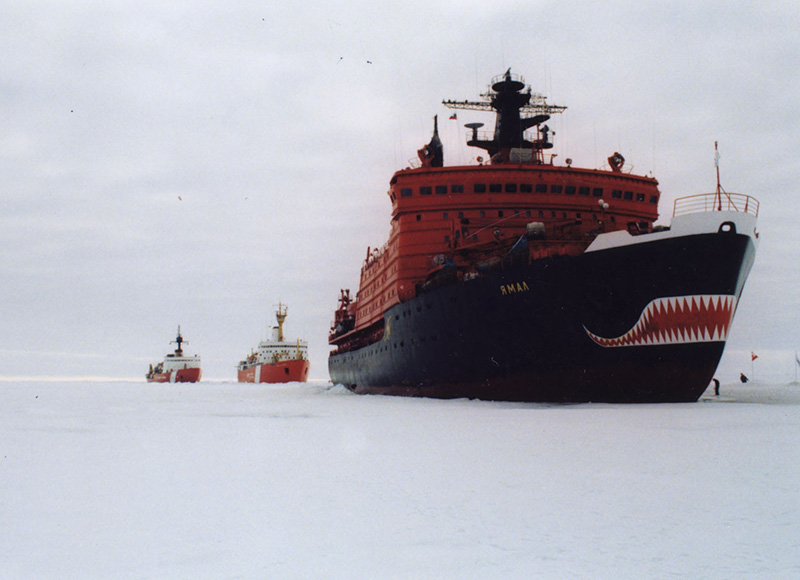The U.S. has limited capabilities to provide national security and shipping safety in the increasingly ice-free and busy Arctic region, and building one heavy icebreaker will do little to address significant U.S. gaps in the area, according to an Arctic policy expert.
While the U.S. lacks a comprehensive policy for the region, Russia is forging ahead with aggressive plans to extend and strengthen its presence in an area that provides 20% of its GDP, 22% of its exports and is home to two million Russian citizens, according to Heather A. Conley, senior vice president for Europe, Eurasia and the Arctic at the Center for Strategic and International Studies in Washington.
Interest among the eight Arctic countries in further developing the region’s shipping lanes and energy resources is on the rise as melting ice makes this remote area more accessible for longer periods of time. Commercial shipping traffic along the Northwest Passage and Northern Sea Route has increased despite often challenging and dangerous conditions.

A 2012 map of the Arctic Region. Image courtesy of the University of Texas Perry-Castañeda Library map collection.
With control over 50% of the Arctic coastline, Russia is “an Arctic superpower and considers the region a key development driver of the country,” Conley said, especially for defense, shipping and energy development. “This is why they have extensive icebreaking capabilities and have very ambitious plans for the region.”
Russia currently has 40 icebreakers operating there and another 11 planned. The United States has two, while a 2011 study showed that it needs 6-10 to meet growing demands in the region.
Conley told a congressional hearing on Coast Guard icebreaking capabilities in the Arctic on July 12 that the Russians are reopening 50 previously closed Soviet-era military bases in the Russian Arctic, putting in place ambitious energy development plans, and positioning military personnel and 10 new search-and-rescue centers along the Northern Sea Route. They have also held several unannounced military exercises.
Meanwhile, the Arctic has been “largely an afterthought for U.S. policymakers.,” and U.S. policy, although developing, lacks “clarity, leadership and budget prioritization.” For some, U.S. goals should involve missile defense, while others stress search and rescue operations, oil spill response, energy security or providing for the needs of residents of coastal villages.
She told the House Subcommittee on Coast Guard and Maritime Transportation, that “we need the capability to protect the United States, to do search and rescue, oil spill response and today we don’t have the capabilities we need to effectively do that. That’s been [the case for] many years, and we will have gaps for several years to come.”
Conley also encouraged more engagement with Russia to avoid future miscommunications or accidents: “The projection of [U.S.] power in the Arctic will be multi-faceted and require a new U.S. approach to the region.”
But it’s clear, she added, that building a single heavy icebreaker will not do the job.
While a state-of-the-art vessel will enhance American operational and response capacity, it will take at least 10 years to build, creating a gap in coverage. And when in service, the vessel will be called to work in the South Pole as well.
“Let’s be clear: One icebreaker is not a silver bullet, nor is it a substitute for enhanced satellite communications, aviation assets, deep-water ports, navigational aides and internationally approved hydrographic mapping,” she told lawmakers.
A new icebreaker would also not solve funding challenges of building radar sites in Alaska that track aircraft through Alaskan airspace or a new Coast Guard station above the Arctic Circle that would improve search and rescue.
“It is only one piece of the larger Arctic security puzzle,” she said, adding that “it is my fear that our near-exclusive focus on acquiring one heavy icebreakers will be deemed sufficient for future U.S. Arctic readiness.”
Conley noted that since Royal Dutch Shell ended its drilling operations and decided not to pursue its leases, numerous infrastructure and research projects have come to a halt. Last October, the Army Corps of Engineers postponed a study on feasibility of building its first deepwater port to support vessels in the Arctic.
Security in the Arctic will be challenged in August when the Crystal Serenity, a 1,700 passenger cruise ship sails from Alaska through the Northwest Passage to Greenland and New York. In tandem, the Coast Guard is planning a search-and-rescue exercise that month.
“Simply put, U.S. national security needs and challenges in the American Arctic far surpass existing Coast Guard implementation capabilities and the value added of acquiring one heavy icebreaker,” Conley said.
U.S. policy is evolving in the region. President Obama visited recently and launched a program to support construction of a new heavy icebreaker, expand scientific research and accelerate mapping of the Arctic. The Coast Guard, which has been operating in the region since the U.S. purchased Alaska from Russian in 1867, has also developed an Arctic strategy.




